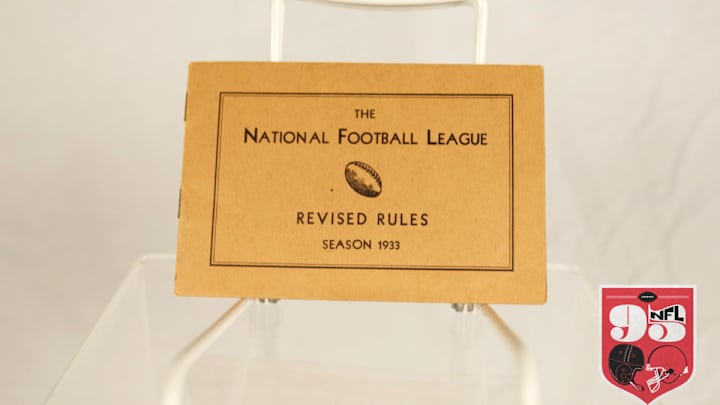The 1933 Rule Book

The MMQB presents NFL 95, a special project—unveiled every Wednesday from May through July—detailing 95 artifacts that tell the story of the NFL, as the league prepares to enter its 95th season. See the entire series here.
The rules have allowed the forward pass in the professional game since 1906. George “Peggy” Parratt of the Massillon (Ohio) Tigers is believed to be the first player to complete a pass in a pro game, with Dan “Bullet” Riley on the receiving end, against Benwood-Moundsville (W.Va.) on Oct. 25 of that year.
But it was hardly ever used because of stiff penalties for incomplete or illegally thrown passes. For instance, the passer had to be five yards behind the line of scrimmage, and the penalty for failing to do so was a turnover even if the pass was incomplete. A controversy bubbled up in the 1932 championship game between the Chicago Bears and Portsmouth Spartans, when Bears fullback Bronko Nagurski faked a run and then threw a touchdown to Red Grange. The Spartans protested that Nagurski wasn’t five yards behind the line of scrimmage. The play stood, and the Bears later won, 9–0.
At the league meetings after the season, Spartans coach George “Potsy” Clark asked for a rule change to legalize any pass thrown from behind the line of scrimmage. The move, which would transform football and lead to the aerial show we see today, wasn’t meant to further the pro game, which had adopted the college rules to that point. It was because, Clark argued, “Nagurski would do it anyway!”
—Greg A. Bedard
After playing its first 13 seasons strictly under collegiate rules, the NFL established some of its own for the 1933 season. The first rule on page 3 was a huge step toward modernizing the passing game. (Courtesy of the Pro Football Hall of Fame)


